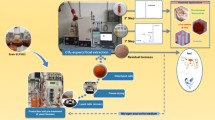Abstract
Industrial ethanol fermentation is a non-sterile process and contaminant microorganisms can lead to a decrease in industrial productivity and significant economic loss. Nowadays, some distilleries in Northeastern Brazil deal with bacterial contamination by decreasing must pH and adding bactericides. Alternatively, contamination can be challenged by adding a pure batch of Saccharomyces cerevisiae—a time-consuming and costly process. A better strategy might involve the development of a fungicide that kills contaminant yeasts while preserving S. cerevisiae cells. Here, we show that polyhexamethyl biguanide (PHMB) inhibits and kills the most important contaminant yeasts detected in the distilleries of Northeastern Brazil without affecting the cell viability and fermentation capacity of S. cerevisiae. Moreover, some physiological data suggest that PHMB acts through interaction with the yeast membrane. These results support the development of a new strategy for controlling contaminant yeast population whilst keeping industrial yields high.



Similar content being viewed by others
References
Silva-Filho EA, Melo HF, Antunes DF, Santos SKB, Resende AM, Simões DA, Morais MA Jr (2005) Isolation by genetic and physiological characteristics of a fuel-ethanol fermentative Saccharomyces cerevisiae strain with potential for genetic manipulation. J Ind Microbiol Biotechnol 32:481–486
Basílio ACM, Araújo PRL, Morais JOF, Silva-Filho EA, de Morais Jr MA, Simões DA (2007) Detection and identification of wild yeast contaminants of the industrial fuel ethanol fermentation process. Curr Microbiol 56:322–326
De Souza-Liberal AT, Basílio ACM, Brasileiro BTRV, Silva-Filho EA, Simões DA, s Jr MA (2007) Identification of the yeast Dekkera bruxellensis as major contaminant in continuous fuel ethanol fermentation. J Appl Microbiol 102:538–547
Abbott DA, Hynes SH, Ingledew WM (2005) Growth rates of Dekkera/Brettanomyces yeasts hinder their ability to compete with Saccharomyces cerevisiae in batch corn mash fermentations. Appl Microbiol Biotechnol 66:641–647
Vanden Bossche H, Engelen M, Rochette F (2003) Antifungal agents of use in animal health—chemical, biochemical and pharmacological aspects. J Vet Pharmacol Ther 26:5–29
Loureiro V, Malfeito-Ferreira M (2003) Spoilage yeasts in the wine industry. Int J Food Microbiol 86:23–50
Messik CR, Pendland SL, Moshirfar M, Fiscella RG, Losnedahl KJ, Schriever CA, Schreckenberger PC (1999) In-vitro activity of polyheamethylene biguanide (PHMB) against fungal isolates associated with infective keratitis. J Antimicrob Chemother 44:297–298
McDonnell G, Russell D (1999) Antiseptics and desinfectants: activity, action, and resistance. Clin Microbiol Rev 12:147–179
Allen MJ, White GF, Morby AP (2006) The response of Escherichia coli to exposure to the biocide polyhexamethylene biguanide. Microbiology 152:989–1000
Seal D (2003) Treatment of Acanthamoeba keratitis. Expert Rev Anti Infect Ther 1:205–208
Passoth V, Blomqvist J, Schnurer J (2007) Dekkera bruxellensis and Lactobacillus vini form a stable ethanol-producing consortium in a commercial alcohol production process. Appl Environ Microbiol 73:4354–4356
De Souza-Liberal AT, Silva-Filho EA, Morais JOF, Simões DA, Morais MA Jr (2005) Contaminant yeast detection in industrial ethanol fermentation must by rDNA-PCR. Lett Appl Microbiol 40:19–23
Gomez-Rivas L, Escudero-Abarca BI, Aguilar-Uscanga MG, Hayward-Jones PM, Mendoza P, Ramırez M (2004) Selective antimicrobial action of chitosan against spoilage yeasts in mixed culture fermentations. J Ind Microbiol Biotechnol 31:16–22
Neves L, Pampulha ME, Loureiro-Dias MC (1994) Resistance of food spoilage yeasts to sorbic acid. Lett Appl Microbiol 19:8–11
Bom IJ, Klis FM, de Nobel H, Brul S (2001) A new strategy for inhibition of the spoilage yeasts Saccharomyces cerevisiae and Zygosaccharomyces bailii based on combination of a membrane-active peptide with an oligosaccharide that leads to an impaired glycosylphosphatidylinositol (GPI)-dependent yeast wall protein layer. FEMS Yeast Res 1:187–194
Comitini F, Di Pietro N, Zacchi L, Mannazzu I, Ciani M (2004) Kluyveromyces phaffii killer toxin active against wine spoilage yeasts: purification and characterization. Microbiology 150:2535–2541
Thomas LV, Ingram RE, Bevis HE, Brightwell P, Wiulson N, Delves-Broughton J (2005) Natamycin control of yeast spoilage of wine. Food Protect Trends 25:510–517
Enrique M, Marcos JF, Yuste M, Martínez M, Vallés S, Manzanares P (2007) Antimicrobial action of synthetic peptides towards wine spoilage yeasts. Int J Food Microbiol 118:318–325
Muñoz A, Marcos JF (2006) Activity and mode of action against fungal phytopathogens of bovine lactoferricin-derived peptides. J Appl Microbiol 101:1199–1207
Khunkitti W, Hann AC, Lloyd D, Furr JR, Russell AD (1999) X-ray microanalysis of chlorine and phosphorus content in biguanide-treated Acanthamoeba castellanii. J Appl Microbiol 86:453–459
Beney L, Gervais P (2001) Influence of the fluidity of the membrane on the response of microorganisms to environmental stresses. Appl Microbiol Biotechnol 57:34–42
Aguilera F, Peinado RA, Millán C, Ortega JM, Mauricio JC (2006) Relationship between ethanol tolerance, H+-ATPase activity and the lipid composition of the plasma membrane in different wine yeast strains. Int J Food Microbiol 110:34–42
Gibson BR, Lawrence SJ, Leclaire JPR, Powell CD, Smart KA (2007) Yeast responses to stresses associated with industrial brewery handling. FEMS Microbiol Rev 31:535–569
Herdeiro RS, Pereira MD, Panek AD, Eleutherio ECA (2006) Trehalose protects Saccharomyces cerevisiae from lipid peroxidation during oxidative stress. Biochem Biophys Acta 1760:340–346
Acknowledgments
The authors thanks to Dr Gustavo de Bilerbeck (INSA-Toulouse, France) by his critical discussion on the paper, to the Brazilian funding agencies CNPq (Conselho Nacional de Desenvolvimento Científico e Tecnológico) and FACEPE (Fundação de Amparo à Ciência e Tecnologia do Estado de Pernambuco) by the financial support and scholarships, and to the companies AEB Bioquímica Latino Americana S.A. (Paraná State) for providing PHMB and JP1 commercial preparations and Japungu Agroindustrial distillery (Paraíba State) and Miriri distillery (Paraíba State) for their logistic support to this work.
Author information
Authors and Affiliations
Corresponding author
Rights and permissions
About this article
Cite this article
Elsztein, C., de Menezes, J.A.S. & de Morais, M.A. Polyhexamethyl biguanide can eliminate contaminant yeasts from fuel-ethanol fermentation process. J Ind Microbiol Biotechnol 35, 967–973 (2008). https://doi.org/10.1007/s10295-008-0371-4
Received:
Accepted:
Published:
Issue Date:
DOI: https://doi.org/10.1007/s10295-008-0371-4




